2001 – Part Four
There is a point in every endeavor where you meet the point of diminishing returns. This point makes itself brutally evident in all sorts of aspects of motorcycle racing. For instance, you might be able to improve your laps times by two seconds switching from a $3,000 motorcycles to a $10,000 motorcycle but then it might take another $10,000 to get the next half second. And then you reach the awful point where more money does not yield improvements at all and you have to rely on improvements in talent or skill. For most club racers this is about halfway through their second season as an Expert. The realization is usually coupled with retirement from motorcycle racing.
Maintenance on racebikes often falls into this category of diminishing returns and/or misplaced energy. On the one hand you have racers whose lack of mechanical ability leads them to compulsively wash their bike when it really needs to have the valves adjusted. Or, more simply, don’t perform tasks that are inconvenient. On the other hand you have people who superstitiously perform maintenance on a bike that far exceeds any perceptible benefit.
For instance, many racers do not have an easy way to support their bike in such a manner that the front end is off the ground and the movement of the front end is unencumbered. Because of this, steering head bearing adjustment often goes without attention despite being one of the most crucial aspects of the motorcycle’s handling (see "Give it another click of steering damper"). Keeping the shock linkage bearings properly greased is another instance where I have seen even professional race mechanics neglect this tedious chore to the point where the linkage functioned more like a ratchet than a system of levers. And you know that very same bike had nicely polished bodywork. A case of the mechanic doing what he wanted to do (make the bike look pretty) instead of what he should have done (made the bike work properly).
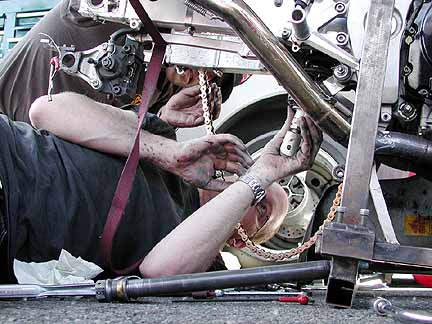
Tim chooses an inopportune moment to check the grease in
the suspension linkages.
And the same folks will overdo the chores that are either more familiar or less intimidating. For instance, many club weekend sprint racers will diligently change the engine oil on their bikes every single weekend. For the most part, the average club weekend involves maybe 2.5 hours of running time. The endurance racers, such as ourselves, will run engine oil for 8, 10 or 24 hours before draining it out, and, often that oil is still serviceable. Despite the best intentions, extra oil changes will not make the bike faster or, actually, even make the engine last longer. (Unless you’re doing something really stupid like running 0-weight oil.)
Or spark plugs. Although AOD has been known to be thrifty to a fault. ("Change the clutch plates? But we only have one season on them.") We ran almost the entire 2001 endurance series on a single set of spark plugs. We only changed them (and they were the stock plugs) at the last event of the year when a discussion of spark plugs led Nolan to remove them all for inspection and he just couldn’t bring himself to reinstall the perfectly serviceable, but ancient, plugs back into the engine.
Since most racers function on a finite budget, proper allocation of funds (grease for the linkage and steering head bearings or lube and adjustment of the chain instead of yet another set of plugs and oil change) will yield benefits well before the point of diminishing returns.
These are the kinds of things that fill my head while driving across Nebraska; where the youth were suspiciously hip and happy at midnight at the Perkins Family Restaurant. Melissa and I were driving across Nebraska to Salt Lake City on our way to Portland International Raceway. Although we were excited (and remember, excitement is not always good) about trying a new track, we were less-than-pleased at the fact that the multi-thousand-mile drive to Oregon had discouraged many of the usual WERA endurance competitors which would, instead, set us up for a humiliating defeat at the hands of fast locals.
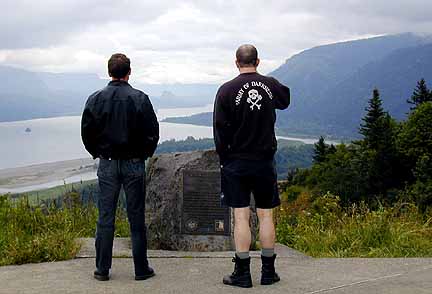
Cross-country drives do have their moments.
This one is in the Columbia River Gorge.
Melissa and I elected to drive the rig out while Jim, Tim and Steve Bacon would drive the rig back from West to East. Melissa made the trip more interesting by insisting on scenic detours onto tiny mountain roads, with the 20-foot trailer. And for those of you who have never had the pleasure of seeing the Columbia River Gorge area, don’t die wondering.
Portland International Raceway
Portland, Oregon
June 30, 2001
Driving west we, at regular intervals, watched large CART semis passing us heading the other way. Upon our arrival at PIR we realized that the CART trucks had just been at PIR the previous weekend. I do not think the arrival of the motley motorcycle transporters filled the void in the pits created by the departure of the CART transporters.
The Portland race also included the first AMA Pro Thunder round to be held in conjunction with the WERA National series. This was to be the cause of both our tribulation and salvation. The WERA round was also being hosted by OMRRA, the local racing organization at PIR. This meant that many of the race conventions (flags, etc.) would be performed to OMRRA custom and not to WERA standards. This would, most notably, be with regards to the treatment of oil on the track. At virtually every other track I have been to, oil on the track is greeted with either a red flag or, at the least, a waving red-and-yellow flag. OMRRA has the corner worker make a big "O" with their arms and did not seem to believe in stopping on-track activities for the presence of oil on the track, either in practice or the race.
I received an object lesson on the various treatments of oil from both Pro Thunder Buells and the cornerworkers. In a late practice session on Friday I entered the cold-tire turn four (PIR really only has one real left and two slight lefts, which makes it impossible to keep the left side of the tire warm) when, at the exit of the turn, I unceremoniously fell over from almost vertical.
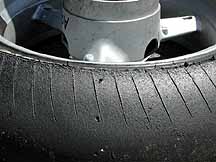
An attempt to get heat into the left side of
the tire was completely ineffectual on 10w-40.
I balled up (AOD standard crash procedure is to make a fist, cross the fist across your chest, and try to ball up if possible) and tumbled to a stop. Our beautiful bike was lying in the sand next to me. At first I thought I had overcooked the corner on cold tires (despite that lap being about my fifth of the session) but the cornerworker who approached me warned me to get away from the track as there was oil in the turn.
I glanced at my bike. The engine covers were intact so I assured the cornerworker that I hadn’t dropped any oil on the track.
"No, no, no. Someone else oiled the track. You were about the fifth bike to slide through that turn. We were going to show a flag soon but we red-flagged it when you crashed."
Of course, that information would have been handy before I entered the turn.
Apparently a Buell had a hole in its required oil-catching lower and had leaked enough oil out of the engine to properly protect the racing surface against galling, pitting and corrosion.
I rode the bike back to the pits sore but largely intact, to let the crew assess the damage while I found someplace quiet to lick the wounds to my shoulder and pride.
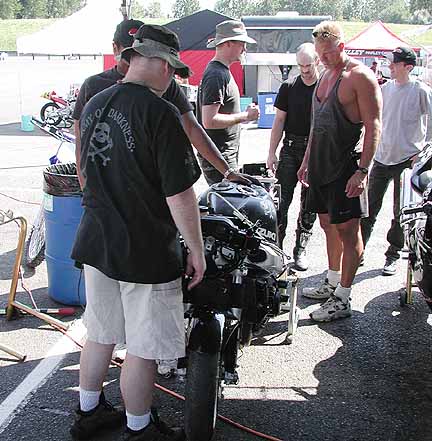
"Oh. Great. Now what are we going to do? I don’t want to rain on your
parade, man, but we just got our asses kicked. That’s it man! Game Over!"
This incident eventually caused some controversy as well. The OMRRA officials and cornerworkers could not have been more enthusiastic, welcoming and diligent to the wayward WERA crowd. I spoke with the WERA officials who were present and said that maybe oil on the racing line should be taken a little more seriously, and, of course, since I only had about 30 percent range of motion in my left arm I might have had a slight tone of agitation in my voice when I made my observation. This apparently got around as proving that AOD was somehow anti-OMRRA and resulted in a brief flurry of whispers in the pits and querulous onlookers.
Back in the pits, Tim and the boys were going to work. Scott Fisher had crashed the Neighbor bike shortly after I crashed the AOD bike. He said he didn’t want me to get all the attention so every available person was put to work building raceable bikes for the following day’s event while I packed ice on various joints and wondered about my ability to endure the 6-hour endurance.
The choice to switch from our A bike to our B bike was made easy by the appearance of cracks in most of the subframe mounts on the A frame. This, despite the fact that the tail section was, for the most part, intact. Suzuki took a fair amount of weight out of the new frame and with it, a fair amount of durability. The other major problem was that our previously flawless Walgren-crafted gas tank was caved in on the top. While some of the crew set to switching suspension components between the two bikes, Tim and Dana (a master metal fabricator who is the shop foreman at Scott Fisher’s outfit) removed the gas cap and the fuel pump so they could bang out the dents from inside the tank.
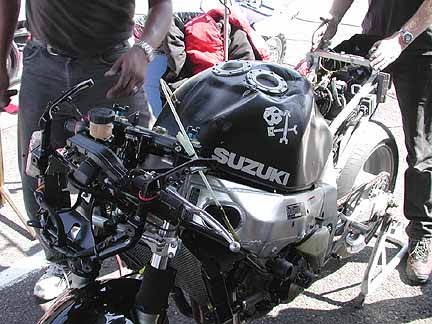
Amazingly this tank was not only quick filling but retaining fuel three hours later.
Progress was slow and we had pizzas delivered to the track to keep the efforts going but the sun had long set by the time we had both bikes ready for the next day.
Like Halloween at AOD HQ, racing is often about greed held in check by a healthy dose of fear. Despite the ample amounts of cash available to top finishers of the endurance race, few local teams had decided to run the race. With the absence of the travel-discouraged-regulars we were looking at the smallest WERA endurance grid of the entire season. A guaranteed third place in MWSB paid over $750 in cash and awards so I dashed up to registration to enter a second AOD team. I planned on making about five laps on our cracked-frame A bike before parking it.
Other pre-race chores included finding a reserve rider. Our usual third rider, Brian Stokes, had decided to stay on the east coast to race another series that weekend and, with my stiff and sore shoulder, I was worried about having catastrophic limb failure at some point during the race.
I had just about talked Bill St. John into signing the entry form so I could use him in the race if my shoulder gave out when Jeff Nash walked up and asked Bill if he knew anyone who needed a rider for the endurance race. Step right this way, Jeff.
Jeff was an absolute pleasure to work with. We told him how the team worked. We told him how the bike worked and, being the consummate professional, he just said "Okay". After he went out and put in a competitive time on the bike in only four laps of practice he came in and wanted to discuss strategy.
Tim always gets all weak and wiggly when famous Pros say nice things about his bike. Jeff put forth that the AOD bike was pretty damn fast and was working very well. Although Jeff was enthusiastic about riding the bike, he suggested that, as a tactical decisions, we only schedule him to ride one stint because, you know, his hand is broken.
I guess I’ll just shut up about my sore shoulder now.
Jim and Scott started the race on the AOD/NOTB bikes, respectively. Scott showed that he has not completely left his Willow roots behind because he had immediately adapted to Portland’s collection of Willowesque right-handers. Jim was playing it a little more conservative. Meanwhile, I took five laps and parked the A bike to collect third place in class.
Scott was out front of the 600s, dicing with Team Chaos. Jim was lagging back about 10 seconds or so. After the first pit stops Melissa went out to chase Chaos’s Matt Kramer. Melissa, again with the Willow background, was very comfortable at Portland and was slowly reeling in the Chaos 600. I walked over to Chaos member Mark Crozier on the wall and asked if he was watching the same thing that I was watching. He nodded and grimaced. I suggested "Looks like in five laps we are going to have a race out there". He agreed and pointed out that my crew was signaling that it was time for me to go ride the motorcycle.
Jim pitted us in about seventh place, first MWSB, but third 600. I rode for a stint in an unremarkable fashion and brought the bike back in fifth overall since both the NOTB and Chaos bikes had hit the ground. We were back into first 600.
Jeff got on the bike. Jeff is one of those rare veteran riders who looks almost effortless while riding motorcycles. He went out and did a bunch of reasonable laps, then did a bunch of faster laps, then a bunch of really fast laps. None of his time groupings varied by more than a tenth of a second. He went faster as his stint wore on and the fuel load lightened. At one point I showed him the +2L (plus two laps) board and he eased back a-quarter-of-a-second a lap and held it there until the tank ran low and the fuel light started blinking.
He came off the bike completely shocked that he had ridden 73 minutes with a broken hand, and fast, saying "That bike is easy to ride".*
At the end of Jim’s stint we were still in fifth place overall with a gap back to sixth. Sixth was Team Chaos, and, although we had a comfortable two-lap lead, Pirelli had offered them a bounty if they were able to beat us (we use Michelin) in one of the endurance races. They had been unsuccessful for the season so far but they were highly motivated to catch us. With Chaos behind, we had two local teams on big bikes in front of us. One of them started sounding bad on the straight and the next couple pit stops they took to remedy the ailment dropped them behind us.
I was on the bike for the last stint, dodging oil spills from blown motors (seriously) and trying not to look at the beautiful sky down the front straight when I noticed a familiar yellow bike pulled off to the side of the track. Vesrah, which had run in the lead all race, had smoked a motor.
We were promoted to third overall. This, of course, meant the overall podium. I think Ducati/ Dunlop-sponsored Jeff was a little shocked to find himself standing on the podium with the scruffy team he had met in the pits that morning, along with our Michelin-shod Suzuki.
We shoveled the remains of our race machinery into the trailer, fed the crew, and half of us took a shuttle to the airport to fly home while Tim, Jim and Steve started the 3000-mile drive home.
*BTW, Jeff Nash is running for AMA Trustee in the South Central AMA region. If you are an AMA member in that region you should vote for him because he is a solid guy. You’d like him if you met him, as well.
AOD-NOTB Van Library 2001
Information Is Like A Virus.
The following books have proved to be very contagious in the AOD race transporter over the last 70,000 Interstate miles:
| Guns, Germs and Steel |
| Hard Evidence |
| American Tabloid |
| Stone Virgin |
| Super Casino |
| An American Gangster in Japan |
| Cryptonomicon |
| Enemy at the Gates |
| Choke |
| Rum Punch |
| Survivor |
